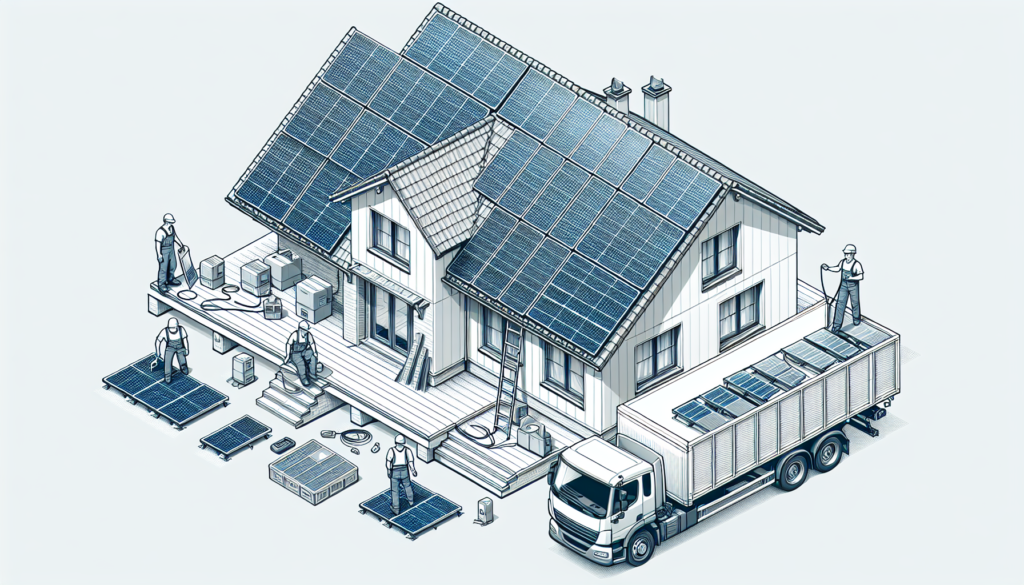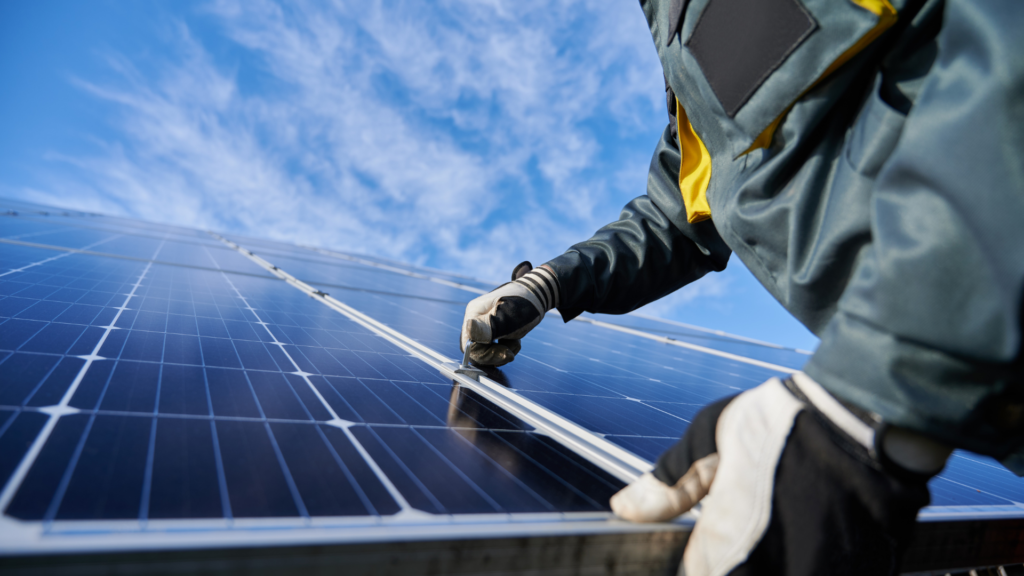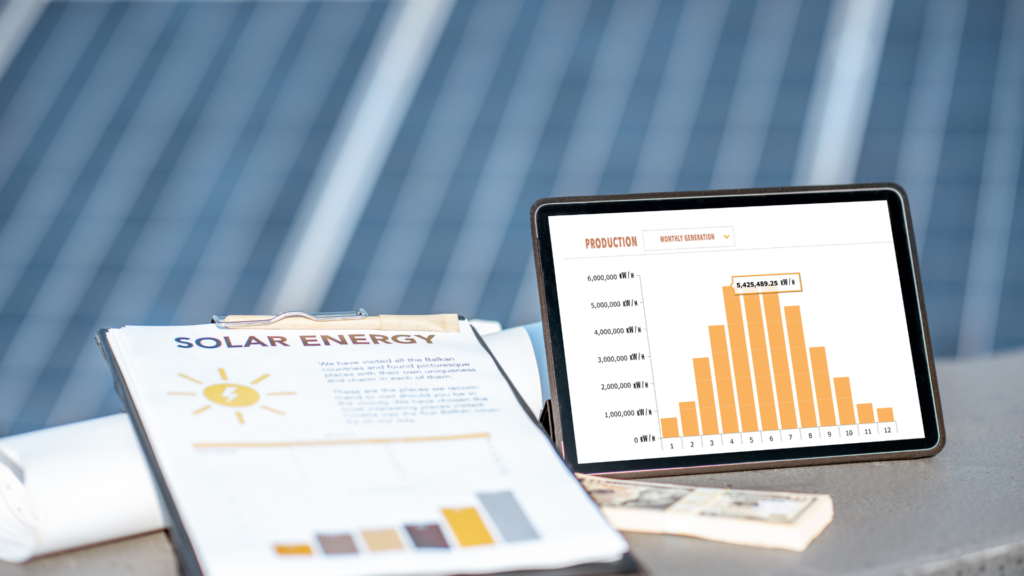To sum up, the path to adopting solar power can be likened to a long-distance race, necessitating careful preparation and endurance. This extensive process stretches out over many months from your first meeting until your panels begin producing energy, requiring collaboration with various stakeholders. By selecting a trustworthy solar installer such as Zircon Solar, who is well-versed in the intricacies of installation and staying actively engaged throughout, you’ll find yourself seamlessly embracing a more sustainable lifestyle powered by solar. Contact us and get solar panels installed today!
Understanding Timelines: How Long Does It Take to Install Solar Panels In NJ?
If you’re asking ‘how long does it take to install solar panels,’ know that the entire process typically completes within 1 to 6 months. Various factors, including legal permits and your system’s complexity, play crucial roles. Keep reading as we break down the timeline for each key phase and discuss what might extend or reduce the duration of your solar panel installation.
The Solar Panel Installation Timeline Explained

The timeline for installing solar panels can vary widely, typically ranging from 7 to 25 weeks. This timeframe encompasses all the steps beginning with the initial consultation and extending through to connecting your new system to the power grid. On average, you might expect this entire process of installing solar panels to span about three months. Keeping in constant communication with your chosen solar installer is crucial as it helps stay informed of any adjustments that may occur.
When considering installation, a reputable solar company will guide homeowners through every step of their journey, offering a free quote and addressing any questions they have regarding the installation process. It’s important not just to anticipate an immediate completion. Patience plays a significant role since how long it takes to install can differ based on various factors. Remember that great achievements take time—much like Rome wasn’t built overnight! Trust in professional experts when deciding on adding these clean energy systems into your home and enjoy stepping towards sustainability.
Initial Consultation and Quotation
Embarking on the transition to solar power typically starts with an initial meeting where key details about the process of installing solar are shared. At this point, your property’s suitability for solar energy is assessed and a discussion regarding your energy requirements takes place.
Subsequently, you’ll receive a comprehensive plan from the installation company detailing:
- Estimated costs
- Projected financial benefits
- Options for equipment
- Expected schedule for completing the installation
The entire procedure leading up to this stage usually spans around one week—just enough time to enjoy some coffee while envisioning a more sustainable future.
Site Survey and Design Phase
Moving forward on your solar venture, you’ll encounter the site survey and design stage. This crucial step entails a thorough evaluation of your roof’s compatibility with solar panels along with crafting a tailored layout to optimize energy yield. You may find it intriguing that advanced tools such as drones and specialized software play integral roles in this phase – indeed, they’re instrumental when installing solar.
Before kicking off the installation process, securing approval of the proposed design from you, the homeowner, is essential. After all, this is your foray into solar power, ensuring your perspectives are considered at each juncture of this journey remains paramount.
Permitting and Paperwork
The process of obtaining essential permits and clearances for installing solar panels typically spans 4 to 6 weeks. It is the responsibility of the solar installers to manage this aspect, which encompasses acquiring local building and electrical permits as well as submitting all necessary paperwork to local government bodies for sanctioning.
It’s important to note that these permitting periods can experience holdups based on a range of factors such as the response times of local governments or particular regulations set by homeowner associations (HOAs). During this waiting period, you might consider educating yourself about the advantages offered by harnessing solar power.
Key Steps in the Solar Installation Process

Delving into the core aspect, which is the actual solar panel installation process, it usually spans one to two days. It’s important to note that there might be a temporary power shutdown for safety reasons during part of this period.
The installation process for solar panels encompasses several distinct phases and demands proficiency in numerous domains including:
- Initial consultation
- System design
- Acquisition of permits
- Physical installment
- Regulatory inspection
- Integration with the electrical grid
Although the physical implementation may appear brief—merely a couple of days—the whole endeavor is an intricate blend of successive steps from start to finish.
Preparing Your Home for Solar
Before mounting residential solar panels on your roof, it is crucial to prepare and confirm that the structure of your home can bear their weight. This process includes an inspection for structural integrity and may necessitate repairs or even reinforcement of the framework. If your current roofing material is nearly worn out or incapable of holding up the new system, you might have to consider re-roofing before installing solar panels.
A thorough evaluation will be conducted on your electrical panel to determine whether it has sufficient capacity for additional circuits and the increased amperage demand from solar panels. Should an upgrade be required for this electrical panel — which often incurs a cost around $2,800 and potentially lasts between 4-8 hours depending on complexity — it’s worth factoring in potential future requirements such as connections for electric vehicle chargers so that its capability remains sustainable over time.
Installing the Solar Panels

The installation of your solar panels is an exciting event! The time it usually takes to get the panels installed ranges from one to three days. This duration varies based on how large and complex your solar panel system is. During this process, a frame is set up using scaffolding, then secured onto the roof before attaching and wiring up each individual panel.
Various brands and technologies associated with solar panels may influence how long the installation will take since some models come with mounting systems that simplify the task. As you observe the skilled installation team meticulously fasten each panel in place using both roof anchors and solar mounts, keep in mind their critical function in capturing sunlight for energy generation.
Connecting to the Grid
After the successful installation of the panels, the subsequent phase entails integrating them with the power grid. To accomplish this, green lights from local authorities and power companies are imperative. They conduct an examination to verify that all components align with regulatory standards. Linking up with the grid conventionally encompasses several steps.
- Attaining final inspection by municipal entities.
- Acquiring consent from energy providers.
- Initiating operation of your system.
- Executing conclusion procedures.
The duration for these tasks can fluctuate. It is common for acquiring both final inspection certification and authorization from utilities to take roughly one week’s time, followed by a commencement and concluding period potentially stretching across another one to three weeks.
During this interlude, as you anticipate full confirmation on your setup, consider arranging a festivity? You’re on course to join forces with others in embracing renewable energy – quite a cause for commemoration!
Factors Influencing Solar Panel Installation Duration
You may have realized that installing solar panels isn’t something that can be done in a single day. The time it takes to complete the installation is affected by various elements including how complex your solar panel system design is, unforeseen weather disruptions, and the availability of necessary components.
Speaking, given these conditions, setting up solar panels can take anywhere from three weeks up to a few months. Patience pays off when you’re waiting for such beneficial outcomes!
Complexity of the Solar Panel System
The complexity of your solar panel system plays a critical role in determining the duration required for installation. Roof-mounted solar systems tend to be installed more quickly than those mounted on the ground, given that they take advantage of an already present structure – your roof.
When you’re deciding on the dimensions of your solar system, keep in mind that larger setups necessitate a more extended installation phase compared to their smaller counterparts. Hence, it’s important to recognize that when it comes down to setting up time for your solar panels, size is indeed an influential factor!
Local Code Requirements and Inspection
The process of securing permits, including the need to adhere to city electrical codes and best practices, is a critical step in the installation timeline. This permitting process can extend schedules due to local code requirements and mandatory inspections.
Ensuring that solar installations meet compliance measures like proper flashing around roof mounts for water leakage prevention must align with local building regulations. While these standards could prolong the installation duration if adjustments are necessary, experienced and trustworthy solar installers usually have strategies to reduce such delays effectively.
Utility Company’s Permission to Operate
Another element that may affect the timeline is obtaining permission to operate from the utility company. Submitting an application for Permission to Operate (PTO) triggers a review process, and approval can be expected within a timeframe ranging from one week up to a full month.
In order to grant approval for your solar system, utility companies require certain documents including spec sheets for components as well as wiring diagrams. These are essential in certifying that the design of your solar power setup adheres to safety standards and regulatory codes. Thus, patience is necessary while anticipating the go-ahead from the utility provider. This step ensures your venture into solar power is both secure and effective.
The Entire Process: From Day One to Solar Energy Generation

The complete procedure of installing a solar system, from the initial step to its conclusion, unfolds as follows: Initially, you must ink a deal with a solar installer. The overall timeframe for getting the solar panels up and running typically stretches across several months after signing this contract.
During the installation process of these panels, various parties are engaged. These include:
- The homeowner
- The company responsible for providing the solar service
- Organizations in charge of issuing permits
- And lastly, your utility provider
Such involvement can lead to complex situations during installation. Various factors like intricacies within your specific solar setup design could prolong timelines. There might also be local obstacles or broader market dynamics at play which impact speediness. Potential delays due to any bottlenecks encountered while handling permit applications may arise.
The Importance of Choosing a Reputable Solar Installer
Due to the intricate nature of solar installations, selecting a reputable solar installer is crucial. To ensure you make an informed decision, follow these guidelines:
- Examine reviews of the company
- Obtain various quotations for comparison
- Check for proper licensing and credentials
- Assess how much experience the installer has
Be cautious if there’s an insistence on hastily signing contracts as it might indicate that the solar company may not be highly regarded.
It’s imperative that installers maintain open lines of communication. They should thoroughly explain all aspects related to incentives available for going solar, elaborate on warranty specifics and resolve any queries homeowners might have – this fosters trust and provides clarity in proceedings. Take deliberate steps when choosing your solar partner!
Timeline Expectations Set by Your Solar Company
Your solar company dictates the time frame for completing the installation process, which is influenced by their booking calendar, access to necessary materials, and proficiency in securing permits and passing inspections.
Companies that handle every aspect of the work internally often provide more consistent and manageable timelines for installation than those depending on subcontractors. The availability of materials impacts how quickly the installation can commence. Small-scale solar projects might utilize readily available inventory whereas larger installations could need extra time for ordering specialized components.
What to Expect After Your Solar Panels Are Installed

Once the solar panels have been successfully installed, your adventure with solar energy isn’t quite finished. You’ll want to keep an eye on how well your system is functioning and prepare for a switch to billing that reflects your use of solar power.
Consider the prospect of monitoring how much energy your household generates through these panels and envisioning a possible decrease in what you pay each month for electricity. It’s quite an enticing scenario, wouldn’t you say?
Monitoring Your New Solar Power System
Monitoring your solar power system can be quite simple, involving just a glance at a meter that tracks the kilowatt-hour (kWh) output of the system. What’s more, this functionality often comes with an accompanying mobile app provided by some solar companies for live tracking of your energy production.
After installing your solar setup, it is uncommon to experience delays in the post-installation phase. This is largely thanks to online applications that allow you to observe both power generation and savings directly via your solar inverter from any location, ensuring you remain connected to your system at all times.
Transition to Solar Billing
The shift to solar power billing introduces several adjustments. You’ll still get a bill for the utility service fees and for the power drawn from the grid when it’s nighttime or overcast. These bills might include set fees that are not linked to your electricity usage.
When your home’s energy use is balanced out by what your solar panels generate over a period, this is known as solar offset—this can lead to possible decreases in your monthly electric bills. The post-solar installation cost of electric bills will vary depending on local weather patterns and how much electricity you personally consume. Keep in mind though, every contribution from solar helps reduce those costs!
Get Solar Panels Installed Today!
Save More On Your Electric Bill!
Get A free consultation and see how you can save with solar today!
Free Consultation